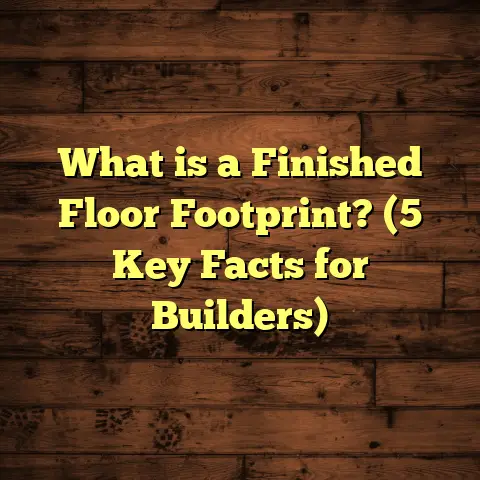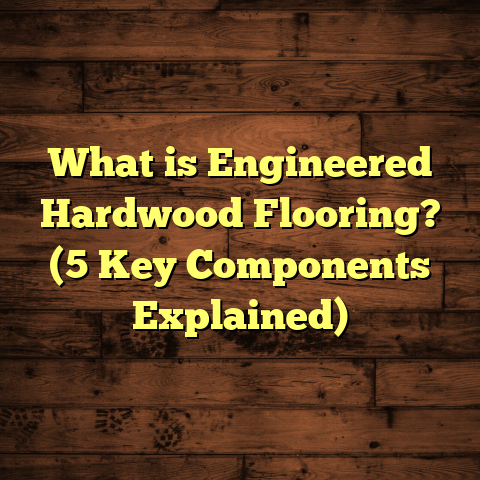What is the Best Flooring: Hardwood or Laminate? (5 Key Comparisons)
Bringing Up Tech Innovations in Flooring Choices
Have you noticed how technology sneaks into every part of our lives? From smart homes to wearable gadgets, it’s changed how we interact with our spaces. Flooring is no exception. Back when I started in this business over a decade ago, hardwood was pretty much the gold standard, and laminate was still finding its footing. Now, thanks to advances in materials science and manufacturing technology, both hardwood and laminate have evolved in ways that make choosing between them both exciting and a little tricky.
For example, new finishes on hardwood can make it more resistant to scratches and moisture than ever before. Likewise, laminate has benefited from improvements in photographic printing and wear layers, making it look astonishingly like real wood while being tough enough to handle the messiest of households.
Since I’ve been installing floors for years, I’ve seen firsthand how these innovations shape not only aesthetics but also durability, maintenance needs, and costs. So, if you’re wondering whether hardwood or laminate is the best floor for you, stick with me — I’ll share what I’ve learned from countless projects and clients.
What Is Hardwood and Laminate Flooring?
Before we jump into comparing hardwood and laminate flooring head-to-head, it’s helpful to get clear on what each one actually is.
Hardwood flooring is made from solid wood planks cut directly from trees. These can be species like oak, maple, cherry, or walnut — each with its own unique grain pattern, texture, and color. Because it’s natural wood, it brings warmth and character that’s hard to replicate. Hardwood floors can be sanded and refinished multiple times over their lifespan, which can span many decades if properly cared for.
Laminate flooring is a man-made product designed to mimic the look of real wood or sometimes other materials like stone or tile. It consists of several layers: a core made of high-density fiberboard (HDF), a photographic layer that provides the visual appearance of wood or other surfaces, and a clear protective wear layer on top. Because it’s manufactured, laminate can offer consistent patterns and colors but doesn’t have the natural variations seen in real wood.
Let me share an example: once I helped a client who wanted the look of rustic oak but was worried about kids and pets scratching the floor. We settled on a high-quality laminate with a textured surface that closely resembled oak grain but was far easier to maintain. That kind of flexibility is something laminate brings to the table.
1. Appearance and Design Options: Which Suits Your Style?
One of the biggest reasons people choose hardwood is for its timeless beauty. There’s just something special about natural wood—the way the grain flows and the subtle color changes that happen over time. Hardwood floors add warmth and elegance to any room.
You can find hardwood in a wide variety of species, each bringing something different to the table:
- Oak: Classic look with prominent grain patterns.
- Maple: Smooth grain with a lighter color.
- Cherry: Rich reddish tones that deepen with age.
- Walnut: Darker, luxurious appearance.
Because each plank is unique, your floor will have character that can’t be duplicated exactly anywhere else. And if you want to switch things up later on, hardwood allows multiple rounds of sanding and refinishing — changing the stain color or restoring shine.
Laminate flooring has really caught up on design versatility. Thanks to photo-realistic printing technology, laminates can mimic not only wood species but also distressed or exotic finishes previously only available in custom hardwoods. You can get ultra-wide planks, hand-scraped textures, even wire-brushed looks that feel surprisingly authentic underfoot.
Here’s a personal story: I had a client who loved reclaimed wood floors but wasn’t ready for the cost or commitment of actual reclaimed hardwood. We found a laminate option with a distressed finish and varied tones that gave her living room the rustic vibe she wanted without breaking the bank.
Design Flexibility
Laminate also offers patterns beyond wood—like stone or ceramic tile looks—which opens up creative possibilities for kitchens or basements where you might want something different.
Data Point
A 2023 Houzz survey found that 67% of homeowners ranked hardwood floors as their preferred choice for living rooms due to aesthetic appeal, while 45% chose laminate for kitchens because of its design variety and ease of cleaning.
2. Durability and Lifespan: What Will Stand the Test of Time?
When it comes to durability, hardwood and laminate behave quite differently.
Hardwood floors are tough but require care. Because they’re solid wood, they can dent or scratch if heavy furniture is dragged across them or if pets have sharp claws. However, here’s where hardwood shines: you can sand out scratches or dents multiple times over the years. This makes hardwood a true long-term investment.
I remember a project where a family had hardwood floors installed before their kids were born. Years later, after countless spills, pet scratches, and toy mishaps, we sanded and refinished their floors — they looked nearly new again. That’s something laminate simply can’t do.
Laminate floors have an extremely durable top wear layer that resists scratches, stains, and fading from sunlight better than many hardwood finishes. This makes them great for high-traffic areas like hallways or rental units where damage is more likely.
However, laminate cannot be sanded or refinished if damaged. Once the surface wears through or chips occur, you need to replace the affected planks or the entire floor.
Moisture Resistance
Hardwood is vulnerable to moisture; water spills should be wiped immediately to prevent warping or cupping. Engineered hardwood offers better moisture resistance but still requires care.
Laminate is generally more water-resistant than hardwood but not waterproof unless specifically designed as such (look for “waterproof laminate” options). Standing water can cause swelling in standard laminates because of their fiberboard core.
Real-Life Example
A client installed hardwood in their kitchen without realizing how much moisture exposure there would be. After two years of small spills not cleaned right away, they had noticeable warping near the sink area. Another client chose waterproof laminate for their basement gym to avoid problems with humidity — it’s held up perfectly after three years.
Lifespan Summary
- Hardwood: Can last 30+ years with refinishing.
- Laminate: Typically lasts 15–25 years depending on wear but must be replaced if damaged beyond surface wear.
3. Installation: How Much Time and Effort Does It Take?
Installation methods differ quite a bit between hardwood and laminate flooring.
Solid hardwood installation often requires nailing or gluing planks down over a properly prepared subfloor. The wood usually needs to acclimate in your home for several days before installation to minimize expansion or contraction after laying. Depending on the size of the project and complexity (like patterns or borders), professional installation can take several days.
Laminate flooring usually features a floating floor system where planks click together over an underlayment without glue or nails. This makes installation faster and easier—many people even choose to install laminate themselves as a DIY weekend project.
From my experience managing installations:
- Hardwood installations require precise leveling of subfloors.
- Minor imperfections in subfloors must be fixed before hardwood installation.
- Laminate is more forgiving — minor subfloor imperfections won’t ruin the result as long as they’re within tolerance.
Time Savings
For a typical 500 sq ft room:
- Hardwood might take 3-5 days including acclimation.
- Laminate can often be installed in 1-2 days including underlayment prep.
Labor Costs
Labor for hardwood installation tends to be twice as expensive as laminate due to complexity and time involved.
Pro Tip
If you’re short on time or want to save on installation costs, laminate flooring is often your best bet without compromising too much on style.
4. Cost Considerations: What Fits Your Budget?
Budget plays a huge role in deciding between hardwood or laminate flooring.
Hardwood floors come with higher material costs — quality boards run from $5–$10 per square foot just for materials depending on species and grade. Add labor costs ($4–$8 per sq ft), plus potential subfloor prep expenses, and you’re looking at $8–$12+ per sq ft fully installed for common species like oak or maple.
Exotic woods like Brazilian cherry or wide-plank hardwoods drive prices even higher—sometimes $15+ per sq ft installed.
Laminate flooring materials range from $1–$4 per sq ft depending on brand quality and design sophistication. Installation labor is cheaper too—averaging $1–$3 per sq ft because it’s faster and simpler.
This price difference means laminate allows you to upgrade flooring in larger areas or more rooms within the same budget compared to hardwood.
Value Over Time
While hardwood costs more upfront, it may add more resale value to your home due to its durability and appeal among buyers.
Laminate offers affordable style solutions but typically doesn’t offer the same boost in home value.
Budgeting Tip
I always tell clients to get multiple quotes from local installers and use online calculators like FloorTally to get realistic cost estimates based on current local market conditions before committing.
5. Maintenance and Care: What Will Keep Your Floor Looking Great?
Your choice should also consider how much time you want to spend maintaining your floor.
Hardwood requires regular sweeping or vacuuming to remove abrasive dirt particles that can cause scratches over time. Occasional cleaning with specially formulated wood floor cleaners keeps them looking fresh without damaging finishes. You have to avoid excessive water during cleaning since moisture can warp wood planks.
Also consider protecting your floors with felt pads under furniture legs and area rugs in high-traffic zones.
Laminate floors are easier maintenance-wise because their tough wear layer resists stains and scratches better than many hardwood finishes. You can clean spills quickly with damp cloths or mops without worrying about damaging the floor surface (as long as standing water isn’t left).
I had a client whose kids frequently dropped food and drinks — she appreciated how easy it was to keep her laminate kitchen floor spotless without special cleaners.
Long-Term Care
Hardwood floors sometimes need refinishing every 7–10 years depending on wear levels which involves sanding down the top layer and applying new finish coats—a professional job costing $3–$5 per sq ft on average.
Laminate floors don’t need refinishing but will eventually need replacement when wear layer thins out after years of use.
Environmental Impact: Which Flooring Is Greener?
As someone who cares about sustainability, I’ve seen more clients ask about eco-friendly flooring options lately.
Hardwood flooring sourced responsibly from forests certified by organizations like FSC (Forest Stewardship Council) supports sustainable forestry practices. Solid wood floors are biodegradable at end-of-life but harvesting trees does impact ecosystems if done unsustainably.
Laminate uses synthetic materials including plastics in its core and wear layers. Although some brands use recycled materials or low-VOC adhesives, overall environmental impact tends to be higher compared to natural wood due to manufacturing emissions and non-biodegradability.
My Viewpoint
If sustainability is key for you:
- Choose FSC-certified hardwood.
- Look for low-emission finishes.
- Consider engineered hardwood (a hybrid) which uses less solid wood per plank.
- For laminate, seek brands with environmental certifications such as GREENGUARD or FloorScore for indoor air quality assurance.
Resale Value: Does Flooring Affect Your Home’s Market Price?
Flooring choices influence how buyers perceive your home when it comes time to sell.
According to Realtor.com data:
- Homes with hardwood floors sell faster and at higher prices than those with carpet or laminate.
- Hardwood floors can add up to 2–3% more value on average depending on region.
- Laminate floors are less likely to add significant resale value but are still better than carpet or vinyl in buyer eyes if well maintained.
I’ve advised many clients who plan to sell within five years to invest in hardwood for better market appeal despite higher initial cost.
Installation Challenges: What Can Go Wrong?
While installing either type seems straightforward on paper, real-life projects often face surprises:
Hardwood Challenges:
- Subfloor must be perfectly level.
- Wood acclimation requires patience.
- Nails can cause squeaks over time.
- Moisture issues cause cupping or gaps if not addressed pre-installation.
Laminate Challenges:
- Subfloor imperfections may telegraph through thin laminate.
- Expansion gaps must be left around edges.
- Some cheaper laminates delaminate or chip after heavy use.
- Water damage risk if spills ignored too long.
Knowing these potential pitfalls helps set expectations for installation day.
Final Thoughts Based on My Experience
From my many years working hands-on with floors, here’s what I keep telling clients:
Choose hardwood if you want:
- Authentic natural beauty that lasts generations.
- Ability to refinish floors multiple times.
- Long-term investment with resale benefits.
- Willingness to spend more upfront and commit to maintenance.
Choose laminate if you want:
- Lower upfront cost with good durability.
- Fast installation with DIY potential.
- Variety of designs including non-wood looks.
- Easier care routines with pets or kids around.
- Temporary solution or budget-friendly whole-home flooring upgrade.
There’s no one-size-fits-all answer here—it depends on your lifestyle, budget, home environment, and design goals. If you want help estimating costs or narrowing choices using tools like FloorTally (which gives local price estimates including waste factors), just ask me!
If you want me to create detailed comparison tables by specific brands or walk you through local labor prices for your area next, I’m happy to help too! Just say the word.





